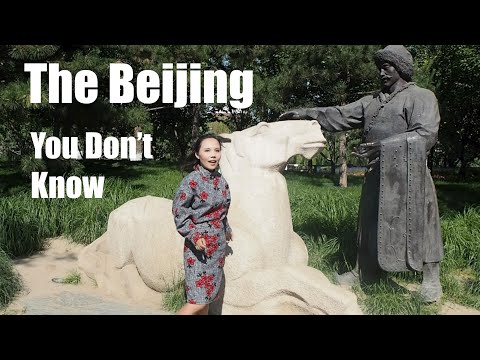The Origin, History of Beijing and Its Nomadic Heritage

Hello, I am Yanyan. This is my last video of 2022. I'd like to end this year with a video about Beijing. This year, the world has been affected by a war between people who at certain point shared the same history. Similar situation happened in China centuries ago. Beijing was that alienated land.
For most of the time during the past 1000 years, its rulers were nomadic people. Its history of being a Capital started with the occupatioin of the nomads. In this video, I'll take you to various sites in the city related to the nomadic conquest empires and tell you the history of Beijing that few people knows.
Let's start from the Beihai Park which many tourists choose to go when they visit Beijing. The lake behind me is called Beihai. It literally means the "northern sea" Across that bridge is the central sea. Further south is the southern sea. The central and southern sea is where the Chinese president's office is located These are the "three sea" in Beijing.
The Forbidden City was constructed by the "sea". I was sitting in the island inside the northern sea. This area is China's "white house".
It's called 中南海, which means the central and southern sea. Why are lakes named sea in Beijing? The nomadic people such as the Mongols call lakes sea It was the nomadic people who named the lakes in Beijing various sea. The story began with the occupying of the city by the Khitan Empire established around the collapse of the Tang Dynasty. In 907, the Great Tang Dynasty collapsed. China was divided into many small states.
In the ensuing 53 years, five regimes ruled north China one after another. Meanwhile, in the Mongolian Steppe, an empire was growing stronger day by day. It was the Khitan Empire. In fighting for power, a Han-general gave 16 prefectures in North China to the Khitan Empire.
in exchange for its support for him to become the new emperor of China. Beijing was among them. The Khitan Empire consequently made Beijing its Southern Capital It was the debut of Beijing on the stage of political center. The city that Khitan constructed was in the southwest of today's Beijing, centered around the southwest 2nd ring road. A pagoda in this area is the only surviving architecture in the city that dates back to the Khitan Empire The pagoda is inside the Tianning Temple. Before the establishment of an empire, Khitan existed as a vassal state of the Tang Dynasty and was heavily influenced by the Tang culture.
Buddhism reached its peak of prosperity in China during the Tang Dynasty. It also became popular in the Khitan Empire. Today it's hard to find any architecture from the Khitan Empire other than stone pagodas of various styles in places that used to be Khitan's territory. There are also many in the suburbs of Beijing. The Khitan Emperors didn't live in Beijing, which was the Southern Capital. The Capital of the Khitan Empire was here, where the Greater Khingan mountain meets the Mongolian Steppe.
But the Khitan emperors didn't stay in their capital either. As nomadic people, the Khitan emperor and his ministers would go hunting and camping in different places in four seasons. During the summer and winter camping, conferences would be held in the camp to discuss state issues. Spring camping was different. They would go fishing in iced lakes and rivers. During the spring camping, the emperor would receive the leaders of the nomadic Jurchen People who lived in this area.
The Jurchen state was a vassal state of the Khitan Empire at that time. So summer and winter camping was similar to today's meetings of State Department. Spring camping was a diplomatic event. The Four-season Camping was how Khitan People incorporated ruling the country into their nomadic lifestyle.
But their nomadic lifestyle was so different from the agrarian lifestyle in the 16 prefectures that historically belonged to China. In order to rule the agrarian region effectively, the Khitan Empire established two parallel administrations. The northern administration governed nomadic areas following traditional Khitan practices.
and the southern administration governed the 16 prefectures adopting Chinese governmental practices. Thanks to this arrangement in governance, the Khitan Empire didn't encounter much resistance in the 16 prefectures. This made it difficult for Han Chinese in the south to recapture the territory. You may know that currently China is a country with two political systems capitalism in Hong Kong and Macao. communism in mainland, It was proposed by the former president Deng Xiaoping. But the "patent" of "one country, two systems" did not belong to President Deng.
It belonged to the Khitans. 53 years after the collapse of the Tang Dynasty, 24 years after the 16 prefectures were given to the Khitan Empire, a new regime was established in north China. It started to unify China piece by piece. It was the Song Dynasty. During the early years of the Song Dynasty, the emperors had numerous attempts to recapture the 16 prefectures but were unsuccessful. Beijing witnessed one of the fieriest battles.
This is Xizhimen, a busy traffic hub in the northwest 2nd ring road. A millennium ago, a battle between the Khitan Empire and the Song Dynasty happened near here. It's called the Battle of Gaoliang River in the history book. But there's no Gaoliang River on today's map, only a street named Gaoliang Bridge Street.
Near this street I found an abandoned bridge with Chinese characters "Gaoliang Bridge" engraved in a stele next to it. The park across the street is called the Park of Nanchang River. But the description on the gate confirmed this river that flows through the Beijing Zoo was the Gaoliang River in history. Walking on the bridge in the center of a modern city gave me a very strange feeling.
It's hard to imagine this was an ancient battlefield. In 979, in order to recapture the 16 prefectures that were occupied by the Khitan Empire, Emperor Taizong of the Song Dynasty led a military expedition in person. He knew the Khitan emperor went hunting and the defense of Beijing was weak. The Song troops recaptured several prefectures on their way to Beijing. Their morale was high.
They laid siege to the city for 20 days but was not able to conquer it. The battle of Gaoliang River happened at night. The Song troops just fought back one Khitan reinforcement force near the Gaoling River and decided to station by the river for the night. That night, another reinforcement force led by Khitan's best general also arrived. The two reinforcement forces and a defense force in the region attacked the Song troops from different directions.
The battle was extremely fierce. The Song Emperor was shot by an arrow in the hip. He fled all the way back to the Song territory overnight all by himself by driving a donkey cart. Tens of thousands of Song soldiers were killed. It was recorded that the water of the Gaoliang River became red with blood.
Ever since, the Song troops suffered Khitan phobia. The person they were scared of the most was that Khitan general, 耶律休哥 He achieved victory in every battle against the Song troops. 25 years later, with the pressure from the Khitan troops that were approaching the Song Capital, the Song imperial court signed a peace agreement with the Khitan Empire in which Song acknowledged the 16 prefectures to be Khitan's territory and agreed to make an annual payment to the Khitan Empire.
The agreement brought peace to the two states for a century but it laid up a big trouble for the Song Dynasty. The 16 prefectures were a natural barrier against the invasion of nomadic people. Once it's lost, the vast land in North China Plain would be exposed to the nomads. A century later, the Khitan Empire was conquered by the empire established by the nomadic Jurchen people. The Jin Empire established by the nomadic Jurchen people was that small vassal state of the Khitan Empire.
The Thucydides Trap once existed between the Khitans and the Jurchens. Facing the rising of the Jurchen state, the Khitans tried many ways to deter its rising. They even performed periodic massacre on male Jurchens to reduce their population. But history tells us once and once again that exterior pressure would not deter the rising of a state once it's on the right track and had strong coercion. Under Khitan's suppression, the Jurchen tribes were unified. They declared the establishment of their own empire and conquered the Khitan Empire.
That was also the nightmare for the Song Dynasty. Two years later, the Jurchens ransacked the Capital of the Song dynasty, captured the Song emperor and took the entire royal family to their Capital in today's northeast China. North China was occupied by the Jurchens. With the ambition to conquer the entire China, the Jurchens moved the Capital south to Beijing two decades later. Before moving to Beijing, the Jurchens spent two years expanding the city constructed by the Khitans New palaces and imperial gardens were built inside the city The city Jurchens constructed was much bigger than the one Khitan constructed.
In 1990, a watergate was discovered in southwest Beijing. It helped archaeologists figure out where the southern wall of the city Jurchen constructed was. A museum was built above the watergate. It's a very interesting museum. There's a lot of information about the two nomadic conquest empires, such as how Khitan and Jurchen people look like. Jurchen people were the ancestor of nomadic Manchu people who established the last imperial dynasty in China.
That's why male Chinese in the Qing Dynasty had a long braid. The archeologist site is one floor below. Seeing this, you might be as puzzled as I was.
This is what a watergate was supposed to look like. It's a gate on the city wall for a canal to flow in and out of the city. It's part of the urban water supply system. Take the city the Jurchens constructed for example. Water was drawn from the mountains to the west of the city and was stored in a lake outside the city.
Then water was drawn into the city via a canal. There should be a watergate here. The southern watergate was where the canal flew out of the city. This is the bottom of the canal.
It's paved with tiles. And these piles date back 1000 years. This group of sculptures depict the scene of the construction of the city and the palace. This was the designer.
From his look we can tell it's a Han Chinese. Apparently nomadic people who lived in tents were not as sophisticate as Han-Chinese in constructing cities and palaces. So they hired Han-Chinese. The sculptures are in a park named Park of the Capital of the Jin Empire.
It's in the area of the city that the Jurchens constructed. The park is dedicated to a milestone of Beijing the beginning of being a Capital. During the Khitan Empire, Beijing was only the southern Capital. But in the Jin Empire, Beijing was the Capital.
It was the political and economic center. The Jurchens also constructed many infrastructure outside the city. The famous Marco Polo bridge was built during this period. The Beihai Park also dates back to this period. The Jurchens built a palace off the Capital here.
So when the Jurchen emperors were bored, they could spend sometime here with his concubines. Life in Beijing was awesome. It made Jurchens forget where they were from.
Over 2 millennium ago, after studying the rising and falling of nations, Chinese philosopher Mencius generalized a rule: To thrive in adversity and to perish in pleasure. This also applied to the Jurchens who didn't perish during Khitan's periodic massacre. To the contrary, their tribes were unified and they thrived. However, the luxurious life in Beijing became their poison.
In the 13th century, the Jin Empire was conquered by the Mongols. That was another nightmare for the Song Dynasty. Unlike the previous two nomadic people, the Mongols had both the ambition and ability to conquer the entire China. And they did so.
After they conquered the Song Dynasty, they established the Yuan Dynasty in China and proclaimed Beijing to be the Capital. They built a new city to the northeast side of the Jurchen Capital and named it Cambaluc, which means the city of the Khan. Many Han Chinese from North China participated in the war of the Mongols conquering the Song Dynasty. They fought for the Mongols.
They were the vanguards in many famous battles, such as the Siege of the Diaoyu Fortress. In fact, Han Chinese living in north China fought for the Khitans when the Song troops tried to recover the 16 prefectures. They also fought for the Jurchens after the Khitan Empire was conquered. History helps us understand what's happening in Taiwan and Hongkong. From the 16 prefectures were given to the Khitan Empire to when the Mongols launched the war against the Song Dynasty, north China was occupied by the nomads for three centuries.
It was short compared to the 5000 years of Chinese history. but was long enough for the Han Chinese there to lose their identification with China. The China during the entire Song Dynasty was a foreign country to them.
After the Mongols were expelled, in 1368, Ming Dynasty was established with the Capital in Nanjing. Several decades later, a new city was built on the ruin of Cambaluc. With that, the Ming Dynasty shifted its Capital from Nanjing to Beijing. China's political center was shifted from south back to the north. It wasn't simply shifted back to the previous capitals such as Kaifeng Xi'an, or Luoyang.
It was shifted to Beijing, the long occupied land. It's almost the northernmost that our agrarian civilization had reached. No Capital had been established in such latitude in previous dynasties. With this drastic move, North and South reconciled. The country was unified again not only in terms of territory, but also culturally and mentally. The Chinese civilization demonstrated its resilience once again.
When I reflect on this history at the end of 2022, I really appreciate this reconciliation in history. I am Yanyan Thanks for watching the video. Subscribe to my channel. I'll see you next year.
2023-01-05 16:14


